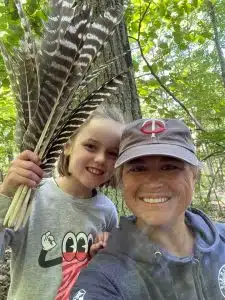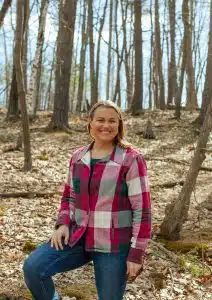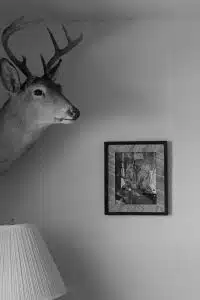Becca’s Bluff Protected with Conservation Easement
 Rebecca Barnard and niece on their annual “turkey feather hunt” on Barnard’s land.
Rebecca Barnard and niece on their annual “turkey feather hunt” on Barnard’s land.
Door County’s forests may look wild, but beneath the canopy, a quiet imbalance is growing—driven by too many deer and too few predators. Native plants vanish under constant browsing pressure, threatening the future of forest regeneration and wildlife habitat. While some see the deer as picturesque, others, like forester and hunter Rebecca Barnard, see a call to action. Her recent donation of a conservation easement to the Door County Land Trust protects both land and the ability to responsibly manage it.
On a recent guided hike with naturalist Terrie Cooper, I learned something surprising: deer haven’t always called Door County home. That’s hard to imagine—especially considering the county ranked 13th in the state last year for deer-vehicle collisions. In 2021, the Wisconsin DNR estimated an average of 56 deer per square mile of deer range in the county.
While difficult to prove with certainty whether deer had existed in Door County prior to the 1800s or not, it is agreed that the species greatly benefited and their numbers have grown significantly since humans impacted the once-forested landscape. Cooper explained that before widespread logging, the dense forests of northern Door County were home to elk—not deer. Deer are edge-browsers by nature, meaning they thrive in open spaces and transitional areas rather than unbroken forest. But in the 1800s, heavy clear-cutting for timber and transitioning the land for agriculture dramatically altered the landscape. The once-thick forests gave way to open habitat more suitable for deer, and elk disappeared from the region.
Door County’s Understory: A Salad Bar for Deer
Today, the future of Door County’s ecosystem faces numerous challenges, including invasive species, development pressures, pests, and a disproportionate population of deer. As forests attempt to regrow, deer browse on saplings and understory plants. A landscape nursery manager once told me that when he was a boy, the dunes at Whitefish Dunes State Park were known as the “Green Hills.” Native yew—a bright green, berry-producing shrub—once blanketed the area. Today, the dunes have little understory, thanks to the rampant deer browse that increased once the park was established and hunting decreased.

One Hunter’s Response: Protect and Manage
For some landowners, hunting is more than a tradition—it’s a way to actively address the ecological imbalance created by overabundant deer. One of them is Rebecca Barnard, who recently protected 18 acres of forested escarpment with a conservation easement with the Door County Land Trust.
As a child, Barnard spent countless nights in a bunk bed on her family’s cherry orchard, gazing out at the blinking lights of communication towers perched above the very escarpment she now helps protect. When the land came up for sale, it took her five years of saving and negotiating to make the purchase. Becoming the owner—and knowing it would never be developed—was a profound relief.
A Conservation Easement with Purpose
The conservation easement established on Barnard’s property allows her to maintain ownership of her land – and the rights to hunt there – while ensuring the Land Trust would enforce development restrictions, no matter who the property is owned by in the future.
Barnard harvested her “biggest buck yet” on opening day in 2022—a perfectly symmetrical white-tailed deer taken on her own property. “That year, I put to good use the battery-heated mittens my parents gave me for Christmas,” she recalls. “It was the coldest and snowiest opening day I can remember in decades.”

A Life Rooted in Forest and Wildlife Conservation
Barnard is a trained forester with a degree in Forest Management and Ecosystem Restoration from UW–Stevens Point and served as President of the Society of American Foresters, the world’s largest professional society representing foresters, in 2024. She also has experience working for a national nonprofit focused on wildlife and hunting conservation, giving her a strong understanding of the delicate balance between human activity and environmental care.
Passing on a Legacy of Land Stewardship
Barnard’s legacy of conservation is shared with her family. Once, on a “turkey feather hunting” expedition on her land, Barnard’s four-year-old niece exclaimed, “Aunt Becca, if we find one more feather, we’re going to find the BIRD!” She also brings her little brother from the Big Brothers, Big Sisters program to experience the wild splendor, where he said he “never knew there were this many trees in the world!”
By conserving the land she loves, Barnard is protecting more than just hemlocks, oaks, and cedars that grow miraculously in the crevices of the limestone bluff—she’s preserving the ecological integrity of a landscape she actively stewards. Aware of how humans have shaped Door County over time, Barnard has dedicated her life to learning how to live in balance with nature.
Through this conservation easement with the Door County Land Trust, the land will be permanently protected for its natural and ecological value, rather than developed into a seasonal home—rarely used and never hunted—where imbalance could quietly take hold. Barnard’s partnership helped the Land Trust surpass a major milestone: protecting more than 10,000 acres of Door County’s lands and waters. Both landowner and Land Trust share a belief that conservation is the surest way to ensure future generations experience this special place as we do today.
About the Door County Land Trust
Protecting Door County’s Exceptional Lands and Waters…Forever. Door County Land Trust protects the wild places, scenic beauty, and ecological integrity that make the peninsula and islands so special. Fifteen featured nature preserves are open for hiking, and other low-impact, non-motorized recreational activities–all at no charge to the public. Trail maps and more information may be found at www.doorcountylandtrust.org.
By Lucy Hodkiewicz

